The pawpaw could be an important food crop for West Africa. It produces numerous seed, which germinate easily and grow fast. Under the right conditions a fair percentage of seed will prosper simply by broadcasting, without being planted or nursed. Again under the right conditions pawpaw can grow at the rate of more than one foot per month and start producing fruit in less than a year. The ripe fruit are juicy and luscious and can be big, with lengths greater than one foot and diameters greater than six inches. One tree can produce well over fifty fruit per year with new fruit developing more or less throughout the year, and without the need for watering during the long, dry season (although this might perhaps improve productivity). The pawpaw has a small physical footprint with a straight trunk and very little branching, which means the trees can be close-packed, potentially increasing yields per acre. West African weather conditions appear very favourable for pawpaw growth.
Many of the above positive statements have caveats. The pawpaw
grows
easily but dies easily. An apparently healthy tree can change, topple
over and give up the ghost in just a few weeks, for no apparent reason.
In any event, even the best-performing trees have a short life, perhaps
three years. This should not be too much of a problem given the
pawpaw's easy germination and fast growth IF the performance of those
trees could be reliably replicated by yearly plantings. But in the West
African setting, with many varieties of pawpaw of unknown
provenance and characteristics grown by backyard gardeners such as
myself, many pawpaw
fail to achieve performance anywhere near the super performers. Many
shrivel and die without reaching maturity or producing a single fruit.
Many others grow tall with stick-like trunks and only produce a few
withered fruit before toppling over. The size of the trunk is a good
early indication of the pawpaw's potential.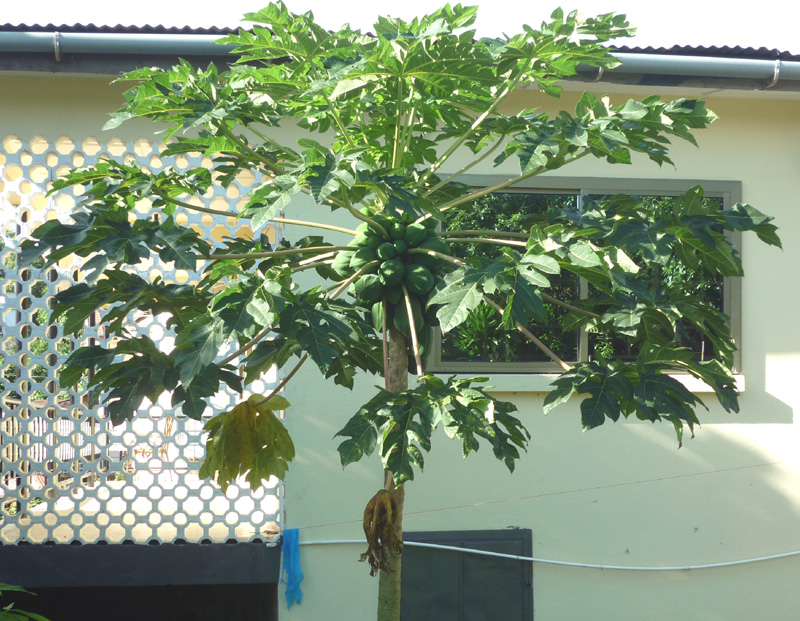 A healthy pawpaw in full
bloom is a joy to behold, more regular in shape than all its
competitors, with a substantial. straight trunk, crowned by
expansive, dark-green foliage at the top and dozens of developing
fruit clinging beneath the leaves. Alas, many of West Africa's farmers
do not enjoy this sight as often as they would like.
A healthy pawpaw in full
bloom is a joy to behold, more regular in shape than all its
competitors, with a substantial. straight trunk, crowned by
expansive, dark-green foliage at the top and dozens of developing
fruit clinging beneath the leaves. Alas, many of West Africa's farmers
do not enjoy this sight as often as they would like.
 A healthy pawpaw in full
bloom is a joy to behold, more regular in shape than all its
competitors, with a substantial. straight trunk, crowned by
expansive, dark-green foliage at the top and dozens of developing
fruit clinging beneath the leaves. Alas, many of West Africa's farmers
do not enjoy this sight as often as they would like.
A healthy pawpaw in full
bloom is a joy to behold, more regular in shape than all its
competitors, with a substantial. straight trunk, crowned by
expansive, dark-green foliage at the top and dozens of developing
fruit clinging beneath the leaves. Alas, many of West Africa's farmers
do not enjoy this sight as often as they would like.A large part of the problem of withered foliage, stunted growth and poor fruit production is undoubtedly due to pests and virus. Pests, visible to the naked eye are perhaps more easily controlled. But microscopic virus are a mystery to the average West African farmer, unsupported by the sophisticated plant research institutes that back up the farmer in advanced countries. Even in these countries, the problems of virus can be insurmountable. Hawaii, the Pacific Island state of the USA, was a leading producer of pawpaw until a virus descended upon its plantations in the 1990s and wiped them out. Hawaii pawpaw production has not yet recovered, although attempts have been made to develop a successful virus-resistant variety through Genetic Modification. We may in West Africa have virus-resistant varieties that have evolved through the process of natural selection. On my mini-farm in Freetown, I often see a healthy pawpaw coexisting cheek and jowl with an emaciated one. Are these different varieties, the one affected by some unidentified virus and the other with resistance to it. I have no idea. And, with a myriad unidentified, unstudied varieties of pawpaw within the West African landscape, I'm not sure anyone does.
The pawpaw is, within my limited knowledge, unique among common Sierra Leonean fruit species in having readily identifiable male and female genders. The males produce copious "flowers" within a few months of germination. Most of the males could be culled - the experts tell us that just one male is needed to fertilize ten or more females. I read one internet account that males can occasionally be changed to females by chopping off the top part of the plant. I have yet to see this happen. A local source told me that he had been told that this change could be accomplished by punching a hole through the trunk. I have yet to accomplish this either. The experts tell us that not only does the pawpaw have male and female genders, but it also has a hermaphrodite version which can produce fruit without the need for a separate male plant. I have yet to identify a hermaphrodite.
The pawpaw is reputed to have medicinal qualities. The ripe fruit can readily be ascertained to be beneficial to the digestive system. Quite a good number of studies indicate beneficial medicinal effects of the fruit, leaves, seed and root.
Pawpaw carries a relatively high price in local (Freetown) markets. Also, a convenient, delicious fruit that is hard to grow in Western climates, it has good export potential. In summary then, pawpaw has much to commend it to West African farmers. Compared to say oranges, one of its local counterparts, it has a better price, much shorter time to first harvest (one year versus perhaps five or longer), better export potential and a smaller footprint. Why though does the pawpaw grow so fast and then topple over and die? Why do many pawpaw shrivel and fade? Can the life of the pawpaw be extended? How can productivity be improved? I wish I knew.
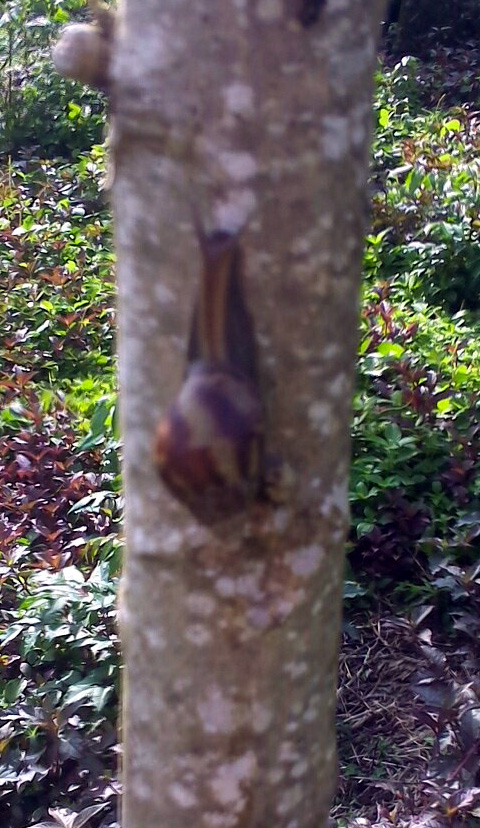
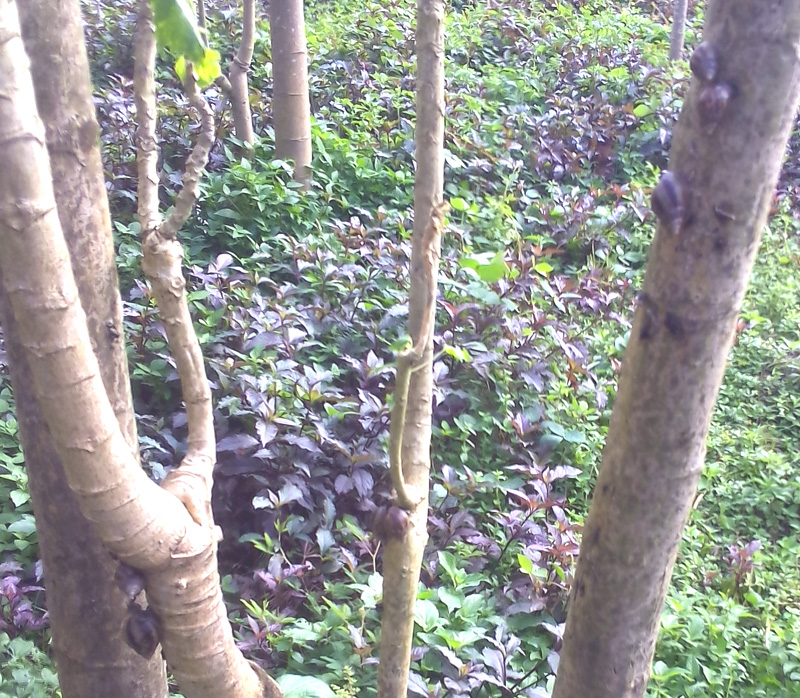 One
day I notice a few snails on one of my pawpaw trees. Vaguely surprised,
I think nothing much of it. Over the years I've occasionally seen
snails on
the property, usually during the rainy season or in damp locations.
Then I see a few more on another tree. And some more. When I finally do
a systematic investigation I discover almost all the trees have snails
on them. There must be a whole colony of them on the property. Internet
research reveals that it's well known that snails thrive on
pawpaw. The leaves, the sap, the trunk, where I find most of them. And
the snails not only feed on the pawpaw tree, destabilizing it, they can
also introduce dangerous
pathogens into it. Perhaps, I think, these unwelcome newcomers are
responsible for much of the stunting and wilting I see in my crop.
Maybe, I've at last found the culprit. What to do about it?
One
day I notice a few snails on one of my pawpaw trees. Vaguely surprised,
I think nothing much of it. Over the years I've occasionally seen
snails on
the property, usually during the rainy season or in damp locations.
Then I see a few more on another tree. And some more. When I finally do
a systematic investigation I discover almost all the trees have snails
on them. There must be a whole colony of them on the property. Internet
research reveals that it's well known that snails thrive on
pawpaw. The leaves, the sap, the trunk, where I find most of them. And
the snails not only feed on the pawpaw tree, destabilizing it, they can
also introduce dangerous
pathogens into it. Perhaps, I think, these unwelcome newcomers are
responsible for much of the stunting and wilting I see in my crop.
Maybe, I've at last found the culprit. What to do about it?I think of a popular ant and termite killer, used locally to treat wood and timber in houses. It has a pungent smell. Surely that will drive the snails off, which I've learnt move up and down the trees daily. I test painting a ring of the insecticide around the trunk of one of my pawpaw trees, just ahead of one of the slow-moving creatures on its way up for a meal. Sure enough, it dislikes the noxious barrier and turns away. I have used this stuff successfully on other types of trees, orange and sour-sop, with colonies of ants living in them. I am hoping it will be just as successfull on the pawpaw.
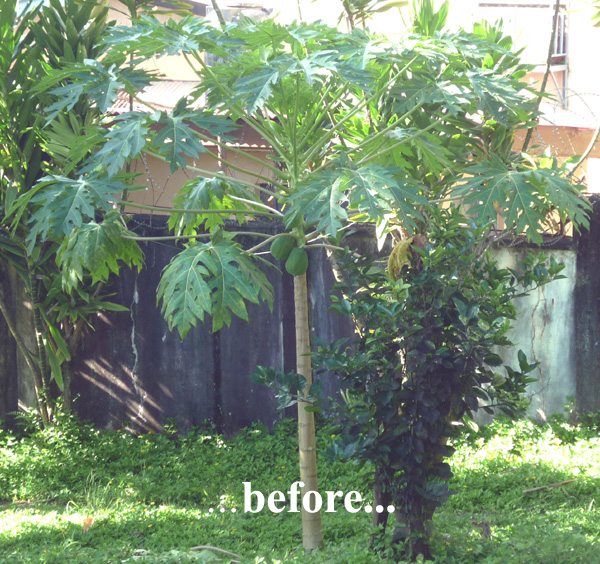
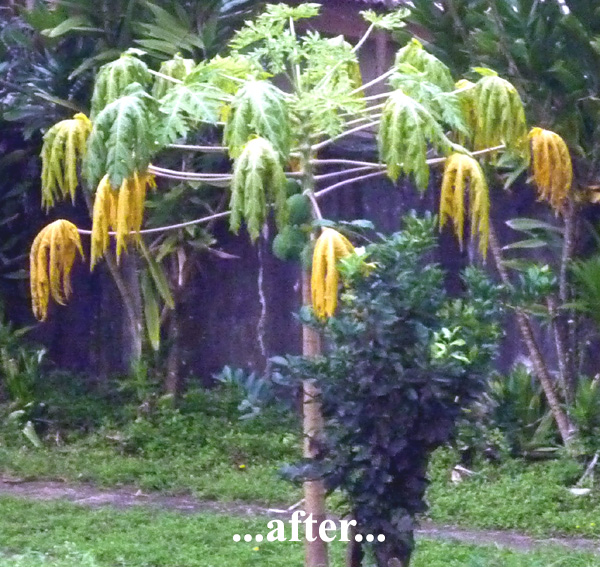 Systematically we rid some 100
pawpaw trees
of all visible snails and
apply the treatment around the base of each tree. Next day I am pleased
to see all my trees apparently rid of snails. The first indication that
all may not be as well as I imagine comes a few days later, when I
notice one of the very young, previously heatlthy trees, with drooping,
yellowing leaves. Over the next few days I am dismayed to find this
repeated on one tree after another. First the young ones, which are
soon toppling over, and then the fully-grown mature trees, some
laden with green fruit. Over a few weeks they lose most of their
foliage, although not the unripe pawpaw on them.
Systematically we rid some 100
pawpaw trees
of all visible snails and
apply the treatment around the base of each tree. Next day I am pleased
to see all my trees apparently rid of snails. The first indication that
all may not be as well as I imagine comes a few days later, when I
notice one of the very young, previously heatlthy trees, with drooping,
yellowing leaves. Over the next few days I am dismayed to find this
repeated on one tree after another. First the young ones, which are
soon toppling over, and then the fully-grown mature trees, some
laden with green fruit. Over a few weeks they lose most of their
foliage, although not the unripe pawpaw on them. 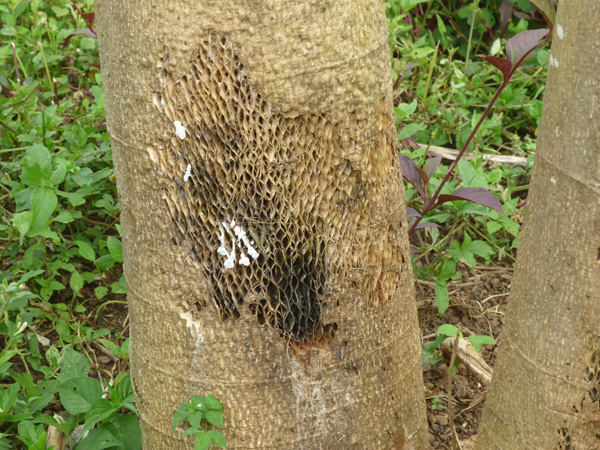
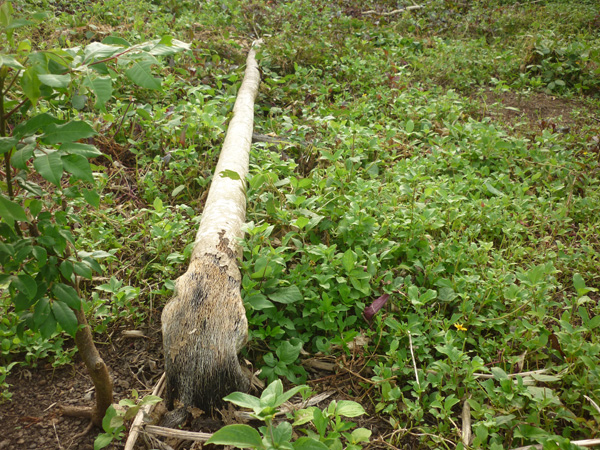 The bark of the trees
in the location where the treatment was applied peels off, to reveal a
honeycomb structure, which gradually rots and weakens until, under the
weight it is supporting, it folds over and the tree topples. More or
less the entire crop is lost, including my young, healthiest, and most
vigorous performers, carefully selected on the basis of previous
plantings. A few mature trees, which either did not receive the
treatment at all or which were given only a minimal application towards
the end of the exercise, survive.
The bark of the trees
in the location where the treatment was applied peels off, to reveal a
honeycomb structure, which gradually rots and weakens until, under the
weight it is supporting, it folds over and the tree topples. More or
less the entire crop is lost, including my young, healthiest, and most
vigorous performers, carefully selected on the basis of previous
plantings. A few mature trees, which either did not receive the
treatment at all or which were given only a minimal application towards
the end of the exercise, survive.Our farmers in West Africa are again forgiven! If I were doing this as a full-time occupation I would be in deep trouble. For the poor and needy, experimentation can be a dangerous business. A little more of the puzzle of why we can't feed ourselves is explained. I'm learning that one of the main challenges in farming in West Africa is control of pests and other unwanted invaders. In a way the environment is too rich; year round it supports allcomers, the whole gamut of pests, viruses, bacteria and weeds.